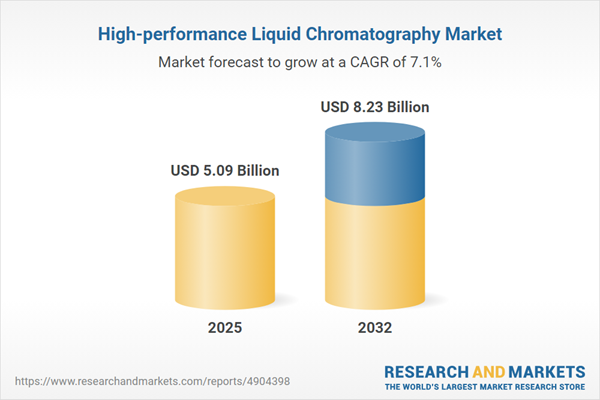Speak directly to the analyst to clarify any post sales queries you may have.
The High-Performance Liquid Chromatography (HPLC) market continues to evolve as a core enabler for scientific and industrial organizations worldwide, supporting stringent quality requirements, regulatory compliance, and operational efficiency in multiple sectors.
High-Performance Liquid Chromatography Market Snapshot
The global market for High-Performance Liquid Chromatography is experiencing consistent expansion, moving from USD 4.75 billion in 2024 to USD 5.09 billion in 2025—driven by a compound annual growth rate (CAGR) of 7.10%, and on track to reach USD 8.23 billion by 2032. Growth is fueled by rising demand in pharmaceuticals, food safety, environmental monitoring, and biotechnology. Key factors include the continuous push for improved throughput, enhanced resolution, compliance with emerging regulations, and adoption of next-generation systems.
Scope & Segmentation
- Product Types: Consumables (cartridges, columns, filters, mobile phase solvents), Instruments (autosamplers, column ovens, detectors, fraction collectors, pumps), Services (installation, maintenance, training, validation), Software (chromatography data systems, data acquisition)
- Techniques: Affinity chromatography, Ion exchange (anion exchange, cation exchange), Normal phase chromatography, Reverse phase chromatography (HPLC, UHPLC, UPLC), Size exclusion chromatography
- Applications: Biochemistry and clinical research (biomarker research, diagnostics), Biotechnology (metabolite analysis, protein purity), Chemical and petrochemical (petrochemical analysis, polymer testing), Environmental (soil testing, water testing), Food and beverage (quality analysis, safety testing), Pharmaceutical (drug development, quality control)
- Regional Coverage: Americas (North America, Latin America), Europe, Middle East & Africa (including Western Europe, Middle East, Africa), Asia-Pacific (China, India, Japan, Australia, South Korea, and surrounding countries)
- Company Coverage: Agilent Technologies, Waters Corporation, Thermo Fisher Scientific, Shimadzu, PerkinElmer, Merck KGaA, Phenomenex, Hitachi High-Tech, JASCO, Bruker
Key Takeaways for Senior Decision-Makers
- HPLC is pivotal in advancing regulatory and scientific rigor, especially for pharmaceutical development, food safety, and environmental quality.
- Demand for ultra-high performance and miniaturized HPLC platforms is rising as organizations move toward precision medicine and rapid biomolecule analysis.
- Sustainability expectations are reshaping manufacturing and procurement, with increased adoption of green solvents, energy-efficient designs, and waste minimization protocols across laboratories.
- Integration of digital systems—machine learning, AI-enabled software, and cloud data management—delivers operational efficiencies, streamlined compliance, and predictive maintenance capabilities.
- Collaboration and co-innovation between leading instrument manufacturers, software providers, and contract research organizations drive rapid adaptation to sector-specific challenges and user requirements.
- Industry consolidation through mergers and acquisitions supports global expansion, improved service delivery, and broader technology portfolios for key market participants.
Tariff Impact on the HPLC Market
The introduction of United States tariffs in 2025 has significantly altered global HPLC supply chains. Import costs for columns, detectors, and essential reagents have increased, compelling organizations to reassess sourcing, evaluate in-house production, and strengthen relationships with suppliers in tariff-neutral regions. Distribution partners and manufacturers are optimizing inventory and, in some cases, relocating assembly closer to end users. These shifts are intensifying focus on flexible procurement, supply chain resilience, and cost containment strategies without compromising technology performance or regulatory expectations.
Market Research Methodology & Data Sources
The research report employs a robust methodology, drawing from structured primary interviews with industry leaders, technical experts, and manufacturing executives. Secondary research includes peer-reviewed literature, official regulatory documents, patent filings, and audited financial disclosures. All data is triangulated for coherence, with qualitative insights complementing quantitative findings.
Why This Report Matters
- Offers a multidimensional analysis of product, technique, application, and geographic trends, equipping leaders with actionable intelligence.
- Assists in identifying emerging market opportunities, optimal procurement strategies, and competitive risks, supporting data-driven decision-making.
Conclusion
High-Performance Liquid Chromatography continues to serve as a cornerstone for innovation and compliance across scientific and industrial sectors. As the market evolves, organizations prioritizing digital integration, sustainability, and adaptive supply chain strategies are best positioned for long-term growth.
Additional Product Information:
- Purchase of this report includes 1 year online access with quarterly updates.
- This report can be updated on request. Please contact our Customer Experience team using the Ask a Question widget on our website.
Table of Contents
3. Executive Summary
4. Market Overview
7. Cumulative Impact of Artificial Intelligence 2025
Companies Mentioned
The companies profiled in this High-performance Liquid Chromatography market report include:- Agilent Technologies, Inc.
- Waters Corporation
- Thermo Fisher Scientific Inc.
- Shimadzu Corporation
- PerkinElmer, Inc.
- Merck KGaA
- Phenomenex, Inc.
- Hitachi High-Tech Corporation
- JASCO Corporation
- Bruker Corporation
Table Information
| Report Attribute | Details |
|---|---|
| No. of Pages | 186 |
| Published | November 2025 |
| Forecast Period | 2025 - 2032 |
| Estimated Market Value ( USD | $ 5.09 Billion |
| Forecasted Market Value ( USD | $ 8.23 Billion |
| Compound Annual Growth Rate | 7.1% |
| Regions Covered | Global |
| No. of Companies Mentioned | 11 |









